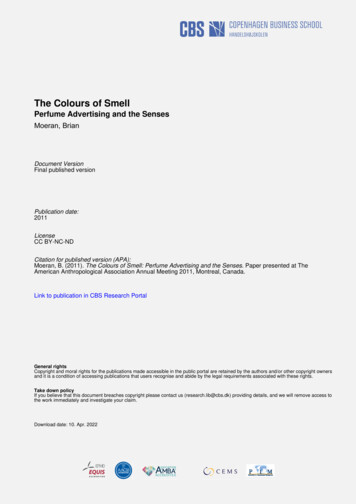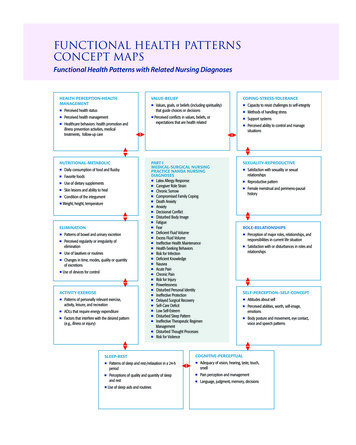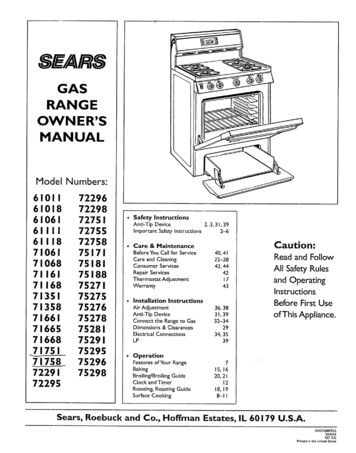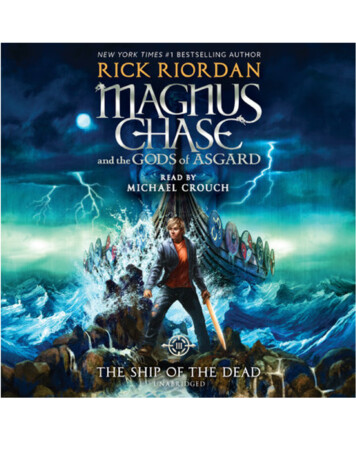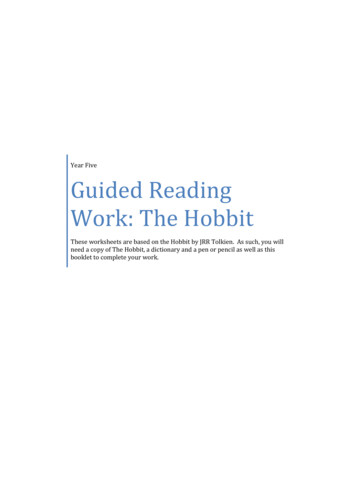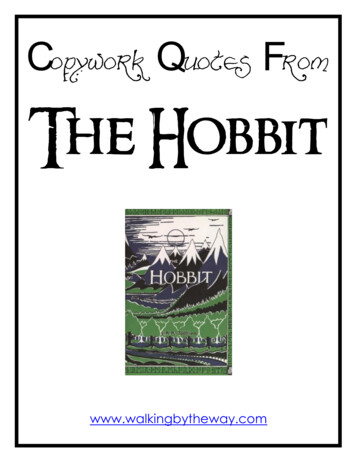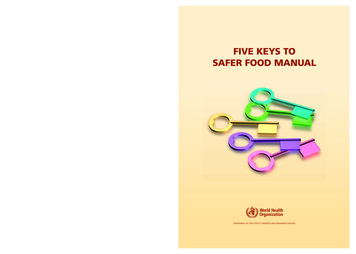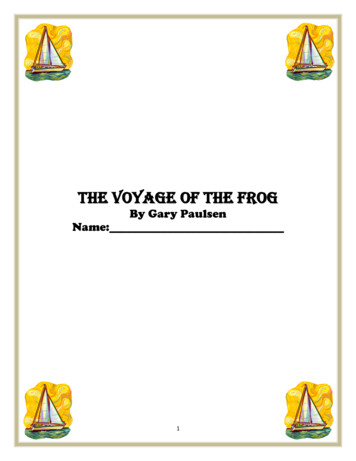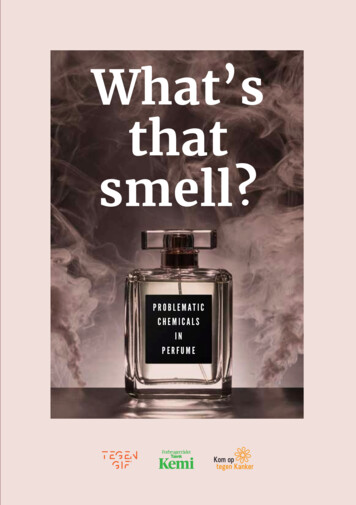
Transcription
What’sthatsmell?PROBLEMATICCHEMICALSINPERFUME
Contents4Introduction6ResultsProblematic chemical ingredients found in 20 perfumes12ResultsPer perfume32COLOPHONSpotlight on endocrine disruptorsWhy Denmark takes EDCs seriouslyCoordinationAnnelies den Boer, TegengifGraphic designMeike Jürgens, it-girl-graphics.comPhotographyMartijn Cieremans Freepic Company40How perfumes are labelled in the EU41Take home messages & Tips for consumersMade in Amsterdam 2022
What’s that smell?5IntroductionPROBLEMATIC CHEMICALS IN PERFUMEMany women regularly use fragranced consumerScientists are increasingly concerned about theseproducts, such as perfume. However, very little ischemical mixtures because people are exposed toknown about the ingredients actually used to givethousands of chemicals at the same time, ofteneach perfume its unique fragrance.in low doses, but in some cases they can inter-Perfumes can contain up to 300 different chem-act and potentiate each other’s effects. IncreasedMore than 2,500 different fragranceconsumer awareness may help in reducing dailyingredients are used in perfumes and perfumed exposure. This is particularly r elevant for vulner-consumer goods. Yet many fragrance ingredientsable groups, such as pregnant and breastfeedingcannot be found on the ingredient list on the ex-women, and women with serious health condi-terior packaging as they are protected as a tradetions, such as breast cancer.icals.1,2secret. Under the EU regulation on cosmetic p roducts, it is mandatory for cosmetics in Europe toFor this study, we have collected informationbe labelled with their ingredients. Fragrances haveon the ingredients in 20 perfumes in Belgium,been exempted from this requirement. Only a fewDenmark and the Netherlands. They were se fragrance ingredients have to be mentioned on thelected based on popularity among consumerslabel. As a result consumers can’t make informedin these countries. The ingredient lists weredecisions to avoid chemicals that could negativelythen analysed for problematic chemicals. In theaffect their health and the environment. following report, you will find the outcomes ofWith this report, we aim to provide more i nsight intoour analysis and we will elaborate on specificwhich ingredients are labelled and used in perfumeshealth concerns related to exposure to substancesand why some of them are of concern. Studiesused in perfume.3,4 indicate that women may use 12 to 16 personal careproducts in a single day, including perfume orfragranced personal care products. This exposesthem to a cocktail of different chemicals daily.
What’s that smell?7RESULTSPROBLEMATIC CHEMICAL INGREDIENTSFOUND IN 20 PERFUMESWe compared the ingredientscontained in the 20 perfumescollected in Belgium, Denmarkand the Netherlands withsubstances of concern listedby several authorative bodies.1This resulted in 26 problematicsubstances in 20 perfumes.The problematic substancescan be categorised in fourdifferent groups:Suspected endocrine disruptingchemicals (EDCs), reprotoxicsubstances, allergens andsubstances that are harmfulto the environment.
What’s that smell?9Reprotoxic substancesReprotoxic substances can haveEndocrine disrupting chemicalsa negative effect on sexual(EDCs)function and fertility in both menSubstances that harmEDCs are chemicals that canand women. Examples of thesethe environmentinterfere with the body’s sensitivenegative effects are low spermUV filters added to cosmetics tohormone system. Hormonescounts in men and miscarriagesAllergenic substancesprotect the skin or prolong theregulate bodily functions, suchin women. These substances mayFragrance ingredients can causeshelf life of the product can haveas metabolism, growth andalso cause developmental toxicityallergies. Allergies are lifelong,a negative impact on marinereproductive development.in children. An increasing numberirreversible conditions withlife. The UV filter ethylhexylThe most minuscule levels ofof studies indicate that fertilitypotentially disabling effects. Skinmethoxycinnamate, which wehormones can have an effectproblems are on the rise in bothsensitisation is a severe consumerfound in several perfumes, hason these functions. Exposuremen and women in the Westernhealth concern, which results inbeen detected in almost all waterto very low levels of EDCs canworld.significant impairment of qualitysources around the world.9therefore have an impact on theseof life and adverse consequencesLimonene, one of the mostimportant systems.for fitness for work. The annualcommon ingredients inEDCs and suspected EDCs arecost to society and the economyfragrances, is classified in the EUfound in food, toys, cosmeticsis projected to be as high as EURas being very toxic to aquatic life.and other consumer products, as240bn in the EU. A Europeanwell as in medicines and plasticpopulation survey revealed thatproducts. Scientific evidence hasat least 4.1% of all adults have ashown that exposure to EDCs hasperfume allergy.867contributed to increases in theincidence of neurodevelopmental,reproductive and metabolicdisorders, as well as somecancers.51-26 ore information on the lists used canMbe found in the annex on page 48.
What’s that smell?11Substances of concern found in 20 perfumesSUBSTANCEP R O B L E MFUNCTIONSAlpha-isomethyl iononefragranceAmyl CinnamalfragranceBenzyl alcoholfragrance, solventBenzyl benzoatefragrance, solventBenzyl cinnamatefragranceBenzyl salicylatefragranceBHT antioxidantButylphenyl methylpropionalfragranceCinnamyl alcoholfragranceCitral fragranceCitronellol fragranceCitrus aurantium amara flower waterfragrance, skin conditioningCoumarin fragranceDisodium EDTAstabilisingEthylhexyl methoxycinnamateUV absorber, stabiliserEthylhexyl salicylateUV absorber, stabiliserEugenol fragranceFarnesol fragranceSUSPECTED EDCGeraniol fragranceALLERGENICHydroxycitronellal fragranceHexyl cinnamalfragranceIsoeugenol fragrancePROBLEMATIC INTHE ENVIRONMENTREPROTOXICLimonenefragranceLinalool fragranceParfum fragranceOctocryleneUV absorber, stabiliser
Results per perfume13My wayPink molécule 090.09eau de parfumeau de parfumGIORGIO ARMANIZARKOPERFUMEPURCHASED IN BELGIUMIngredients: D IN enzyl salicylateEthylhexyl salicylateCitralBenzyl benzoateBenzyl alcoholHexyl cinnamalAlpha-isomethyl iononeIngredients: Parfum
Results per perfume15Lady millionNo 5eau de parfumeau de parfumPACO RABANNECHANELPURCHASED IN THE NETHERLANDSIngredients: ParfumLimoneneAlpha-isomethyl iononePURCHASED IN THE NETHERLANDSBenzyl salicylateHydroxycitronellalHexyl cinnamalLinaloolBenzyl alcoholIsoeugenolCoumarinEthylhexyl salicylateCitronellolGeraniolCitralIngredients: ParfumBenzyl alcoholBenzyl salicylateCinnamyl yl somethyl iononeBenzyl cinnamateCoumarinIsoeugenol
Results per perfume17Good girlAlieneau de parfumeau de parfumCAROLINA HERRERATHIERRY MUGLERPURCHASED IN THE NETHERLANDSIngredients: ParfumCoumarinLinaloolPURCHASED IN THE NETHERLANDSHydroxycitronellalEthylhexyl methoxycinnamateEthylhexyl salicylateHexyl cinnamalLimoneneBenzyl alcoholGeraniolCitralBenzyl salicylateBenzyl benzoateCitronellolIngredients: ParfumBenzyl salicylateEthylhexyl methoxycinnamateIsoeugenolEthylhexyl salicylateCitralCoumarinAlpha-isomethyl iononeBenzyl benzoateBHTBenzyl alcoholLimoneneCitronellolGeraniolLinalool
Results per perfume19PerfectThe scenteau de parfumeau de parfumMARC JACOBSHUGO BOSSPURCHASED IN DENMARKIngredients: ParfumOctocryleneLimoneneBenzyl alcoholPURCHASED IN DENMARKEthylhexyl methoxycinnamateAlpha-isomethyl iononeHexyl nellolBenzyl benzoateIngredients: ParfumBHTLimoneneBenzyl benzoateGeraniolBenzyl salicylateCitronellolHexyl cinnamalEthylhexyl Citral
Results per perfume21Flower by KenzoRomanceeau de parfumeau de parfumKENZORALPH LAURENPURCHASED IN BELGIUMIngredients: ParfumLinaloolIsoeugenolCoumarinPURCHASED IN BELGIUMGeraniolCitronellolAlpha-isomethyl iononeBHTCitralBenzyl salicylateLimoneneBenzyl alcoholHydroxycitronellalFarnesolBenzyl benzoateIngredients: ParfumBenzyl alcoholHexyl cinnamalBenzyl itronellolAlpha-isomethyl iononeCinnamyl alcoholFarnesolGeraniolLimoneneCitral
Results per perfume23Black opiumThis is her!eau de parfumeau de parfumYVES SAINT LAURENTZADIG & VOLTAIREPURCHASED IN DENMARKIngredients: ParfumHydroxycitronellalCitronellolHexyl cinnamalCinnamyl alcoholBenzyl benzoatePURCHASED IN BELGIUMBenzyl salicylateIngredients: ParfumBenzyl alcoholLimoneneAmyl loolEthylhexyl methoxycinnamateBenzyl benzoateBenzyl alcoholBHTCinnamyl alcoholCoumarinIsoeugenol
Results per perfume25J adoreSieau de parfumeau de parfumDIORGIORGIO ARMANIPURCHASED IN DENMARKIngredients: ParfumHydroxycitronellalwaterBenzyl salicylateAlpha-isomethyl iononeBenzyl benzoateBenzyl alcoholPURCHASED IN DENMARKHexyl cinnamalLimoneneBenzyl cinnamateCitronellolIngredients: ParfumBenzyl salicylateBenzyl alcoholCitrus aurantium amara nellalHexyl cinnamalGeraniolCinnamyl alcoholCitronellolEugenolCitralCinnamyl alcoholGeraniolFarnesolCitralAlpha-isomethyl iononeFarnesolCoumarinLimoneneEthylhexylEthylhexyl salicylateBHTBenzyl benzoate
Results per perfume27ScandalLa vie est belleeau de parfumeau de parfumJEAN PAUL GAULTIERLANCÔMEPURCHASED IN BELGIUMIngredients: ParfumPURCHASED IN DENMARKBenzyl salicylateEthylhexyl methoxycinnamateEthylhexyl salicylateBenzyl alcoholLinaloolAlpha-isomethyl iononeBenzyl benzoateIngredients: ParfumLimoneneCoumarinCitralLinaloolEthylhexyl methoxycinnamateGeraniolCoumarinFarnesolBenzyl benzoateCitralBenzyl ethyl iononeBenzyl alcohol
Results per perfume29Twilly d HermèsFlowerbomb nectareau poivrée eau de parfumeau de parfumHERMÈSVIKTOR&ROLFPURCHASED IN THE NETHERLANDSIngredients: ParfumLimoneneAlpha-isomethyl iononeHydroxycitronellalCitronellolCitralPURCHASED IN THE NETHERLANDSEthylhexyl methoxycinnamateBenzyl salicylateButylphenyl methylpropionalLinaloolBenzyl benzoateGeraniolEugenolDisodium EDTABHTEthylhexyl salicylateCoumarinBenzyl alcoholFarnesolIngredients: ParfumBenzyl salicylateEthylhexyl salicylateHydroxycitronnellalGeraniolBenzyl benzoateCitralLinaloolLimoneneCitronellolBenzyl alcoholCoumarin
Results per perfume31SignatureL Interditeau de parfumeau de parfumCHLOÉGIVENCHYPURCHASED IN THE NETHERLANDSPURCHASED IN BELGIUMIngredients: ParfumIngredients: ParfumHydroxycitronellalEthylhexyl methoxycinnamateOctocryleneBenzyl salicylateAlpha-isomethyl iononeCitronellolBHTLinaloolLimoneneGeraniolHexyl cinnamalLimoneneEugenolEthylhexyl methoxycinnamateCitronellolGeraniolAlpha-isomethyl iononeBHTCitralLinaloolBenzyl salicylateCoumarinBenzyl alcohol
What’s that smell?33SPOTLIGHTON ENDOCRINEDISRUPTING CHEMICALSThe use of EDCs is on the risedrastically falling sperm counts,Human biomonitoring studiesas well as hormone-dependenthave found EDCs in Europeans’cancers, such as prostate andurine and blood . EDCs have alsobreast cancer.1011been detected in amniotic fluid12and breast milk, indicating thatBreast cancer and EDCschildren are exposed before andIn 2020, female breast cancer wasshortly after birth.the most commonly diagnosedcancer with 2.3 million newAs early as 2012, the World Healthcases worldwide and the highestOrganization (WHO)13 warned thatincidence in developed countries.17endocrine disrupting chemicalsAround 80% of breast cancerspose a global threat. Eight yearsare oestrogen-dependent.later, the European CommissionA known risk of prolongedemphasised that the use of EDCsexposure to oestrogens is theis on the rise, which poses seriousdevelopment of breast cancer.risks to human health and createsMost EDCs have oestrogenic oran economic cost to society. EDCantiandrogenic properties andexposure during foetal develop can stimulate cell proliferationment may result in negativeand migration, enhancing cancereffects on brain developmentdevelopment and progression as14and growth. Furthermore, EDCswell as reducing the effectivenesshave been linked to reproductive16of chemotherapy.18,19 Threeand fertility problems, such assubstances detected in perfume -15EDCs havebeen linked tofertility problemsand hormonedependent cancerssuch as prostateand breast cancer.
What’s that smell?Vulnerablegroups suchas pregnantand breastfeeding women,young children,teenagersand patientsreceivinganti-cancertreatmentshould beprotected fromexposure toEDCs.35benzyl salicylate, BHT andpresent, only a handful of thesebutylphenyl methylpropional –substances have been regulatedhave been shown to interferein the European Union. Inwith oestrogenic pathways andthe Chemicals Strategy formay therefore increase the risk ofSustainability, the Europeanbreast cancer.Commission acknowledges that20,21the current regulatory frameworkThe pervasive presence of EDCsis unfit to identify and regulateresults in lifelong exposure.endocrine disruptors. As aEDCs can be transferred fromresult of the absence of a firmthe mother to the foetus via theregulatory framework on EDCsplacenta and to the newbornin the EU, several countries,through breast milk. Vulnerableincluding Denmark and France,groups, such as pregnant andhave put in place a nationalbreastfeeding women, youngaction plan to protect theirchildren, teenagers and patientscitizens from EDCs. Moreover,receiving anti-cancer treatment,national authorities in Belgium,should therefore be protectedSweden, Denmark, France, Spainfrom continuous exposure toand the Netherlands have setEDCs.up a website called EndocrineDisruptor Lists (EDlists.org) toOver a thousand chemicals arehelp improve transparency andsuspected to have endocrinethe identification of endocrinedisrupting properties.22Atdisrupting chemicals.23
What’s that smell?37INTERVIEW WITH ANNA-MARIA ANDERSSONWHY DENMARK TAKESEDCS SERIOUSLYCould you elaborate on the work ofnew knowledge on endocrinethe Centre on Endocrine Disruptors?disrupting chemicals (EDCs)with the focus on providingIn the early nineties, a shockwaveThe centre is an interdisciplinaryinformation requested inwent through Denmark. Noscientific network without walls,connection with the preventivefewer than 30 per cent of Danishconsisting of three research groups.work of the regulatorymen were experiencing fertility1. A research group at theauthorities.problems and the incidence ofRigshospitalet, which studiestesticular cancer was increasingendocrine diseases andat an unprecedented rate.reproduction. Furthermore,Denmark is seen by many as a Danish academia and medicalthis group is involved infrontrunner in research, raisinggroups sounded the alarmpopulation studies and humanpublic awareness and governmentbell, indicating that industrialbiomonitoring.measures to protect citizens against24chemicals and endocrineAnna-Maria Anderssonis head of the Danish Centreon Endocrine Disruptors (CeHoS)2. A research group at theexposure to EDCs. Why are EDCs suchdisrupting chemicals in particularUniversity of Southerna priority issue in Denmark (whereaswere to blame for the sharpDenmark, which, among otherother EU countries do not see EDCsincrease in these conditions. Thethings, studies the effects ofas a problem)?Danish government respondedendocrine disruptors on fishwith a national strategy intendedand the aquatic environment.In the 1990s, Denmarkto reverse the trend. Pillars of theFurthermore, this groupregrettably held the world recordstrategy were research, raisingdevelops new test methods forfor incidences of testicular cancer.EDCs.We were also seeing many youngawareness and policy measures,such as national bans on certain3. A research group at the Danishmen with suboptimal semenhazardous chemicals, green publicTechnical University, whichquality. That did not necessarilyprocurement and tax measures,specialises in reproductivemean they could not father atoxicology.child, but they would probablyto discourage the use of endocrinedisrupting chemicals.The main purpose of theneed help. Today, 10% of parentsCeHoS is to build and gatherin Denmark receive some sort
What’s that smell?39of reproductive assistance to getlead to very obvious effects,EDCs, it is important that we dosignals that the EU is taking thispregnant. It is often said that thesuch as malformations in thenot evaluate them one by one.issue seriously. I see this as a leapreason for this is that womanmale reproductive organs, butThis takes too much time. Groupforward.today tend to have children whenmore subtle changes may alsoevaluation for similar EDCs couldthey are older than in previousoccur and only manifest laterhelp to speed up the process. AnWhat would be your best advice todecades. That is not entirelyin life. For example, exposureimportant impediment is that theconsumers to avoid EDCs?fair. There is sufficient evidenceto EDCs may lead to a smalllevel of evidence needed to provethat male subfertility plays anchange in the functioning of thethat a substance is an endocrineI would go for less chemicals.important role.pancreas, which may contributedisruptor is very high and veryThis is not always possible, butScientists and the medicalto the development of obesity orcomplex, which also slows downchoosing products with ecolabelsprofession in Denmark, and Drdiabetes later in life.the process of identification. Iis a good start and a step thatNiels Skakkebaek in particular,also think that producers shoulddoes not require expertise inraised the alarm regarding anbe required to prove that areading and understandingincrease in reproductive health-Our tests showed that severalsubstance they wish to place oncontent lists. If a certain non-related problems in Denmark, to suspected EDCs were present.the market is not an EDC. In theecolabel product is very importantwhich the government respondedShould we be concerned about meantime, the work of consumerto you because it smells verywith a national approach to dealsuspected EDCs?organisations is important andnice or works very well, keepwith this challenge.helps to inform consumersit, but try to go for a fragrance-Many chemicals on the marketabout how they can reduce theirfree option or a product with antoday were introduced beforeexposure to EDCs.ecolabel for your other personalWhy should we be concernedEDCs became an issue. Thousandsabout EDCs?of these chemicals were nevercare or cleaning products. This isespecially important for pregnantproperly tested for endocrineAre there any hopeful/positivewomen or women consideringBecause hormones have a verydisrupting properties, which developments in the area of EDCs?becoming pregnant.important signalling functionmeans that we have a data gapthat regulates functions in theand are therefore engaged in aYes, both the EU Green Dealbody. EDCs can interrupt thathuge human experiment. Sinceand the EU Chemicals strategysignalling function. This maythere are so many suspectedfor sustainability are important
What’s that smell?41Take home messagesHOW PERFUMES ARELABELLED IN THE EUIn the 20 popular perfumes thatto provide full transparency.were purchased in Belgium,Consumers have the right toDenmark and the Netherlands,know which chemicals are used inAccording to the European regulation on cosmeticsuspected endocrine disruptors,their perfume, so they can makeproducts25, the list of ingredients should appear inallergens, a reprotoxic substancean informed decision.descending order of weight. Ingredients in concentrationsand chemicals that are problematiclower than 1% may be listed in any order after thosefor the environment were found.In the absence of a firmregulatory framework in the EU,in concentrations higher than 1%. However, perfumearomatic compositions and their raw materials need onlyOnly two perfumes contained novulnerable groups are at risk,be referred to as ‘parfum’ or ‘aroma’. This means thatsuspected endocrine disruptingincluding pregnant and breast-ingredients that together comprise the perfume or aromachemicals. The rest all containedfeeding women, children andare not specified on the ingredient list. The reason for thisone or more suspected EDCs.people with a serious healthcondition, such as cancer.is that perfume composition is protected as a trade secret.The current system of fragrance safety is based on selfAlthough steps have been taken atThey should receive support toregulation. It is managed by the International FragranceEU level to improve transparencyreduce their exposure to EDCs.Association (IFRA) and its research branch, the Researchregarding fragrance ingredients,Information campaigns targetingInstitute for Fragrance Materials (RIFM). It is unclear toproducers are still not obligedvulnerable groups and healthwhat extent the responsible authorities in the EU memberprofessionals could help themstates monitor the compliance of fragrance ingredientsmake decisions to reduce theirwith the cosmetics regulation.exposure.The EU has seen positive developments in terms oftransparency. Currently, 26 fragrance allergens shouldbe listed on the packaging. The European Commissionis expected to expand the current list of allergens withanother 62 allergens that are common in fragrance.26
What’s that smell?43Tips forconsumersThere are trusted labels out there tohelp you find fragrance-free options,such as the blue label certified byAsthma Allergy Denmark and AllergyFRAGRANCECertified. Products with these labelsare widely available throughoutEurope.REDUCE YOUR DAILY F R A G R A N C E E X P O S U R Epersonal care products you use,In addition to your favouriteYou should also be aware thatREDUCE YOUR EXPOSURET O E N D O C R I N E D I S R U P T I N GCHEMICALS perfume, many of your p ersonalbody lotion and deodorants areIn this study, we found thecare and cleaning productsamong the biggest contributors to following suspected EDCs: contain fragrances. When you addperfume allergy. Benzyl salicylateto reduce your total exposure. BHT Butylphenyl methylpropional Ethylhexyl methylcinnamateIt therefore makes sense to tryALWAYS GO FOR A F R A G R A N C E - F R E E O P T I O NFOR CHILDREN Ethylhexyl salicylateto minimise your exposure toWhen children are exposed to Octocrylenefragrances. For some of you, itfragrance, they risk developingmay be very difficult to part withlifelong allergies. Still, fragranceSeveral other suspectedyour favourite perfume. In thatis used in personal care productsEDCs are used in cosmetics,case, you could consider usingfor children and even newborns.such as b enzophenones,it for special occasions only orAnd it can also be found in lessparabens, cyclopentasiloxane,spraying the perfume on yourobvious products, like toys. Ifcyclomethicone, ethyl salicylate,clothes instead of your skin (butyou want to be sure, check thehomosalate, resorcinol andbeware of stains on your clothes).packaging as fragrance allergenssalicylic acid. ForbrugerrådetYou might also consider choosingin toys must be mentioned on theTænk has found 29 differentfragrance-free options in otherlabel.suspected EDCs in cosmetics.up all the chemicals from theseproducts, you may be exposed to acocktail of problematic chemicals.
What’s that smell?45Looking for these suspectedEDCs on the label is one way ofavoiding the substances, but itis not an easy task. The goodnews is that there are digitalKEMILUPPENYUKA APPAn app developed byThe Yuka app was developed by anForbrugerrådet Tænk for Danishindependent French organisation.consumers, Kemiluppen ratesBy scanning the barcodes of foodcosmetic products A, B or C basedand personal care products, theon the content. By scanning theplatform rates the item and offersbarcode of a product, consumersdetailed information. Since Januarytools available to help you avoidcan identify substances of concern,2018, about 2 million products havesuch as suspected endocrinebeen registered (including 70% ofthem. Several apps are availabledisrupting chemicals and allergens.food products and 30% of cosmeticThe app is available in Danish.products). The app is available infive languages (French, English,to help you identify suspectedSpanish, Italian and German) andendocrine disrupting chemicalsSwitzerland, Luxembourg, Spain,is available in France, Belgium,United Kingdom, Ireland, Canada,or other substances of concern.United States, Australia and Italy.TOX FOXTox Fox is an app developed byIf you don’t feel like using an app,German organisation BUND.a very good alternative to reduceBy scanning a barcode, consumersyour exposure to EDCs is to lookcan identify suspected endocrineout for products that have a trustedecolabel, such as the Nordic Swanand the EU Ecolabel.disrupting chemicals andnanoparticles in consumer itemssuch as cosmetics. The app isavailable in German.
What’s that smell?Lists we haveconsultedto identifysuspected ubstancesand substancesthat are ofenvironmentalconcern.47 Endocrine disruptors lists (2020) Denmark, Sweden, Belgium, the Netherlands and France The EU Commission priority list of potentialendocrine disruptors in cosmetics (2019) Endocrine Disrupter priority list (EU 2007) SIN (‘Substitute It Now!’) List (CHEMSEC) Substances mentioned by theNational Allergy Research Centre (Denmark) List of undesirable substances LOUS list (Danish EPA) List of harmonised classifications (EU) Candidate List of Substances ofVery High Concern for Authorisation (EU) SCCS opinion on fragrance allergens in cosmetic productsand other opinions by the EU scientific committeesSee ‘Opinions open for comments’ List of 26 fragrance allergens subject to individual labelling Listing of POPS in the Stockholm convention The Priority List of the Norwegian Environment Agency Perfluorinated substances The Helsingør statement and The Madrid Statement
What’s that smell?Literature references149THIS PROJECT IS A JOINT COLLABORATIONBETWEEN THE FOLLOWING ORGANISATIONSForbrugerrådet Tænk is an independent Danish https://www.beuc.eu/publications/beuc-x-2018-118 beuc comments to fragrance allergens roadmap.pdf2 rfume/consumer organisation, founded in 1947, which works3 pii/S0278691518308627?via%3Dihubon the promotion of sustainable and socially cts-safety-act-would-improve-cosmetics-safety45 positions/edc6 0356897 https://www.beuc.eu/publications/beuc-x-2018-118 beuc comments to fragrance allergens roadmap.pdf8 rfume/allergi-parfume-hyppighed/consumption. Forbrugerrådet Tænk is the oldest consumerorganisation in Europe. It defends consumer rights andClaus Jørgensen, head of project Forbrugerrådet Tænkhelps consumers to avoid problematic chemicals whenoxybenzone and other sunscreen active ingredients11testing and communication to consumers, the DanishConsumer Council’s Think Chemicals initiative specifically https://www.researchgate.net/publication/326302079 Review of environmental effects of9shopping. les/s41598-020-66284-310makes consumers a force in the market. Through chemical 0165 Factsheet Bisphenols v10 RC WEBdoublespreads-2.pdf https://pubmed.ncbi.nlm.nih.gov/34607043/Kom op tegen Kanker (Stand up to Cancer) is a leading e-endocrine-disrupting-chemicalsnon-governmental organisation in the fight against 0/10/Strategy.pdfcancer in the Flemish region of Belgium. Stand up to 0/10/Strategy.pdfCancer’s mission is to reduce the prevalence of cancer in /common-edcs/reproductionthe Flemish community and improve the quality of life ey.com/doi/full/10.3322/caac.2166017 18 .1186/s12940-020-00670-219 20 /pubmed.ncbi.nlm.nih.gov/29460325/Ann Gils, director of preventionand early detectionKom op tegen Kankernot-for-profit organisation based in Amsterdam. rch-the-goal is a non-toxic living environment. We raise publictedx-list#sname &searchfor any&sortby chemname&action search&searchcats all&sortby chemnameawareness of consumers’ daily exposure to toxic chemicalshttps://edlists.org23 by producing appealing research, campaigning andhttps://pubmed.ncbi.nlm.nih.gov/20171682/24 /?uri CELEX:02009R1223-20190813&from lication/d7e3c77f-433c-11eb-b27b-01aa75ed71a1/26 language-enhttps://www.komoptegenkanker.beTegengif - Erase all Toxins (the Netherlands) is a22 25 people living with cancer.Annelies den Boer,chairperson Tegengifinfluencing policy. We believe that increased awarenesswill both stimulate demand for toxin-free products andincrease public support for regulations leading to atoxin-free world. www.tegengif.nl
Consumershave theright toknow whichchemicals areused in theirperfume, sothey can makean informeddecision.
PROBLEMATIC CHEMICALS IN PERFUME Many women regularly use fragranced consumer products, such as perfume. However, very little is known about the ingredients actually used to give each perfume its unique fragrance. Perfumes can contain up to 300 dif
